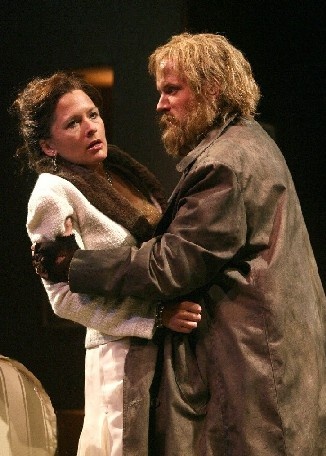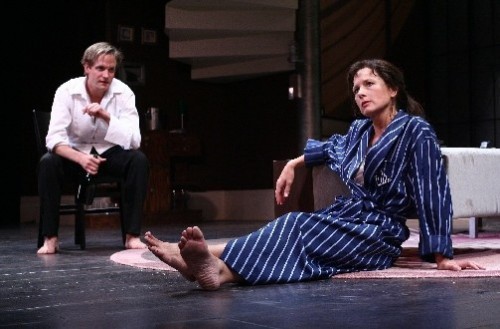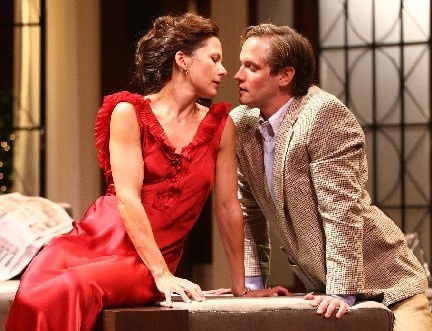Double Double a Hit in Williamstown
Roger Rees Directs His Own Play
By: Charles Giuliano - Aug 30, 2006
Double Double: Written by Roger Rees and Rick Elice. Featuring Matt Letscher and Jennifer Van Dyck Sets, Neil Patel, Costumes, Jennifer Caprio, Lights, Charles Foster, Directed by Roger Rees, for Williamstown Theatre Festival August 16 through 27, 2006
The second season which has drawn mixed reviews for Roger Rees as Artistic Director of the renowned Williamstown Theatre Festival has ended on more solid ground. Reese penciled himself in to direct the globally successful mystery/ comedy "Double Double" which he co wrote, some twenty years ago, with Rick Elice.
Simply put this production proved to be clever, sharply paced and absurdly amusing. It is the kind of witty word play, smart and funny, bait and switch, that one associates with
But back to "Double Double" which provided a night of ridiculous fun. It opens with Phillipa James (Jennifer Van Dyck) spreading newspaper on the floor of an upscale
Standing there in a raggy trench coat under a mop of unruly blondish hair, we are surprised that Phillipa has actually been stalking him for some time. She proposes that for a hundred quid she has a scheme that he will be cleaned up and passed off as her dead husband in order to claim an inheritance on the deceased spouse's 37th birthday just six days hence. But he is quickly on to her, and though destitute, wants no part of the scam until she ups the stakes to split the loot, some two million pounds, fifty fifty. A million pounds proves to be a heady deal for a homeless man. So the fun begins.
By the second scene the transformation begins. He has been scrubbed clean and redressed in her husband's attire in which he makes a striking resemblance to the deceased. Which is why she had stalked him in the first place. The role for Letscher is challenging. He must morph from a desperate homeless man and drunk with a thick Scottish accent into the charming and urbane dead husband. There is a Shavian twist as he must be transformed into the man of the house. The playwrights take that "Pygmalion" reference head on.
He cleans up so well that he begins to have designs on Phillipa involving more than a financial payoff. There is some wonderful comedy as he tries to loose the lower class Scottish accent and speak more like an aristocrat. His transformation is far more complex than hers but we also see a more subtle change in Phillipa as she begins to fall for the tramp now showing his true self as a man and lover. The actors skillfully make the implausible credible. They careen on a collision course, with appropriate twists and turns, to accomplish the elaborate fraud after just six days of an extreme makeover.
Over the mantle is a portrait of the late Mr. James's manipulative mother who set the terms that he would come into an inheritance only if he is securely married on his 37th birthday. But, the plot thickens and there is actually another plan, or "Double Double." By now McFee is quite in love and pleads with Phillipa to just drop the plan and run off with him. Love conquers all and who needs money. It all comes tumbling down, literally and figuratively, in a manner that we cannot reveal. It is after all, a mystery. With a terrific trick ending.
Which leads us to the set designed by Neil Patel which is mandated to entail a vaulted space with a spiral staircase leading to another level and bedroom. During the play Phillipa is frequently seen running up and down the stairs which also allows for dramatic changes of costume including a slinky red evening gown when they dress to receive her friends for a dinner party. The "Pygmalion" ball is intended to introduce the transformed tramp to high society. The staircase is designed in such a manner that the actors are briefly invisible as they move from one level to another. In that sense the set serves the plot adequately but seemed so wrong in every other sense.
During their marriage the couple had lived well on an allowance that they had entirely spent on travel and collectables. The motive for the scam is that the widow is broke. Her husband drowned and was buried on a remote tropical island. But the rather severe set with clusters of African masks on the wall and showcased niches did not reflect that kind of spendthrift collecting of objects. In fact when in the early going McFee lurks about looking for something to snatch the pickings are way too slim to support the plot. Also, the dark chocolate colored walls, with white trim, prove oppressive. Not the kind of hip, upscale interior of swinging young Londoners. The mix of furniture and style was a mess. Was that an Art Deco couch? Just how did that jibe with tourist curios? And the portrait of Mom over the mantle looked like an ersatz Alex Katz pop sendup. The entire set was way too much apples and oranges.
But despite these reservations Van Dyck and Letscher triumphed in providing stunning and convincing performances. Rees had wonderful players to work with to bring forth the full potential of his own script. Now let us see if he has more rabbits in the hat to pop out next season.




